An old railway station at the western end of the train tracks in Jalisco, Mexico, bears witness to unspeakable cruelties perpetrated upon thousands of Yaqui Indians in the early 1900s. According to the Jalisco Secretariat of Culture’s Guachimontones Guide Book, Yaquis were sold as slaves at the station “for 25 centavos a head” and “around the station were located concentration camps where hundreds of native people died of hunger and disease.” This building, now abandoned, is located near the town of San Marcos, 80 kilometers west of Guadalajara, along archeologically rich Jalisco highway 4 (see Jalisco map).
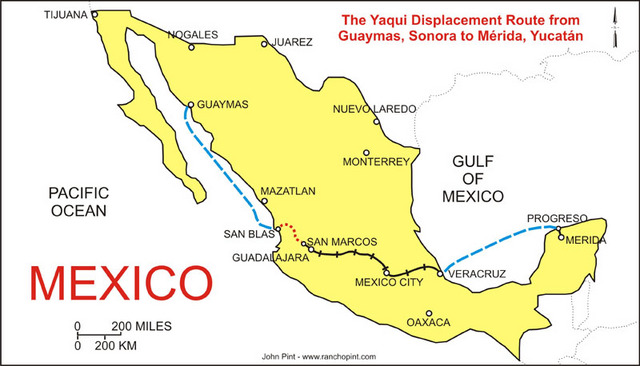
The assertion of these atrocities is not only shocking, but surprising, because slavery was outlawed in Mexico in 1829. However, the sad story of the Yaquis’ fate, at the hands of the Mexican government itself, was related in painstaking detail in a book entitled Barbarous Mexico, available on Amazon, published by an American, John Kenneth Turner, in 1911.
Barbarous Mexico is not an attack upon the Mexican people, but an exposé of the atrocities committed against many of them by President Porfirio Diaz during 34 years of repeated “unopposed reelection.” One of the worst schemes of the Diaz government, says Turner, was the provocation of the Yaqui Indians to rebellion in order to clear them out of Sonora so their land — rich for both mining and agriculture — could be sold to Americans.
The Yaquis were put on boats at Guaymas and shipped to San Blas, where they were forced to walk more than 300 kilometers to San Marcos. Here were large concentration camps where families were broken up. Individuals were then sold inside the station and packed into train cars which took them to Veracruz. Another boat ride brought them to Progreso in Yucatán, from which they were taken to the plantation that would be their tomb.
John Kenneth Turner first learned about this business in 1908, from several Mexicans locked up in the Los Angeles County jail.
“What are you accused of?” he asked them.
“Invading a friendly country,” they replied.
“What country is that?” he asked.
“Mexico,” they answered.
Turner inquired as to why they would want to invade their own country.
“Because the constitution has been suspended and awful things are happening.”
When he asked for concrete examples, the jailed Mexicans told him that great numbers of people were being bought and sold like cattle and forced to work on sisal plantations until they dropped dead — even though Mexico had abolished slavery many years before.
Turner was determined to see for himself and traveled to Mérida where he passed himself off as a rich man anxious to invest in the lucrative henequen hemp business.
Here he discovered that the Yaquis were indeed slaves in the worst sense of the word, beaten bloody every morning at role call, forced to work in the blazing sun from dawn to dusk on little food, locked up every night, and beaten again if they failed to cut and trim at least 2000 henequen leaves per day. The Yaqui women, separated from their families, were forced to “marry” Chinamen and every baby born on the plantation was worth up to $1000 cash to the owner. At least two-thirds of the Yaquis arriving in Yucatan were dead before the end of the first year of such treatment.
Turner was able to interview some of the slaves. One man with a baby on his arm said he was plowing in his field when the soldiers came. “They did not give me time to unhitch my oxen,” he said.
“Where is the mother of your baby?” inquired Turner.
“Dead in San Marcos,” replied the young father. “That three weeks’ tramp over the mountains killed her.”
Indeed, Turner’s informants agreed that “the crudest part of the trail was between San Blas and San Marcos “where women with babies fell down on the roadside, never to get up again.”
Those who grew rich from the atrocities of those days were, of course, Porfirio Díaz, his relatives and cronies, but the book points out that more than half the sisal was shipped to the U.S. and Turner accuses wealthy families such as the Hearsts, the Rockefellers and the Guggenheims of having profited the most from the expropriated lands of the Yaquis and Mayas as well as the “Flaming Hell” of the henequen plantations.
The Yaqui people were famed for being hard-working and strong. Between 1904 and 1909, according to Turner, around 15,000 of them were rounded up, forced along the tortuous route to Yucatán and enslaved. Despite their extraordinary strength, most of them died within the first year on the plantations, raising questions of whether they were the victims of genocide.
The San Marcos train station ought to house a memorial to these Yaquis, as it is probably the only remains of a concentration camp still standing in Mexico. Instead, there is not even a plaque commemorating the pain and sorrow suffered here, only the stark shell of the empty building and a silent grove of tall eucalyptus trees where the Indians were once penned up.
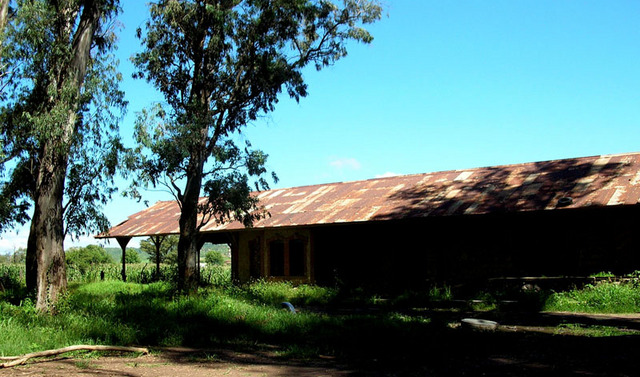
Today, few citizens of the area are aware of the atrocities which took place in their now abandoned train station. Eighty-year-old Juan Díaz of San Marcos remembers stories of “false promises made by President Porfirio Díaz” in those times and recalls that those who took the bait “were rewarded by becoming slaves in the henequen plantations,” Others say they remember rumors that Yaqui Indians had been sold in the San Marcos train station. Nevertheless, not one of the ten Histories of San Marcos found in the local library mentions a word about the mistreatment of Yaquis in the area.
Turner’s book raised eyebrows at the time of its publication and has even been called “the Uncle Tom’s Cabin of slavery in Mexico.” As it is filled with passion and indignation, it might not be considered objective. A more scholarly treatment of the same subject, however, was published by Duke University Press in 1974. This is Development and Rural Rebellion: Pacification of the Yaquis in the Late Porfiriato by Evelyn Hu-Dehart, a professor of history at Washington University in St. Louis. She further explored the issue in Yaqui Resistance and Survival: The Struggle for Land and Autonomy, 1821-1920, available on Amazon.
Hu-Dehart confirms the great majority of Turner’s claims, with the notable exception of his assertion that the Yaquis were essentially peaceful. “The Diaz government did not provoke the Yaqui rebellion, but inherited it,” says Hu-Dehart, who points out that the Yaquis inevitably sided with anyone fighting the authorities and refused to accept any deal giving them less than the one thing they wanted: complete autonomy in their lush corner of Sonora.
Interestingly, Hu-Dehart’s unemotional paper provides hard evidence for what might seem Turner’s most controversial accusation: that the government of Porfirio Díaz deliberately attempted the genocide of the Yaqui Indians. “The government is… disposed to exterminate all of you if you continue to rebel,” wrote General Lorenzo Torres to the chief of the Yaquis in 1908.
A recent development sheds new light on Diaz’s war on the Yaquis. According to Mark Stevenson of the Associated Press, New York’s American Museum of Natural History has — after a lapse of more than a century — returned the remains of massacred Yaquis to their tribal home in Sonora, Mexico.
Twelve skulls and other remains constitute some of the first forensic evidence of Profirio Diaz’s brutal campaign to eliminate the tribe. The massacre occurred in 1902 when a party of exiled Yaqui men, women and children were ambushed by heavily armed Mexican soldiers. During what is now considered one of the last large-scale Indian massacres in North America, a great number of Yaquis were brutally butchered. As many as 900 troops may have been involved, according to anthropologist Ales Hrdlicka, who visited the scene shortly after the attack. Modern forensic studies carried out by Amherst anthropologist Ventura Perez show that many of the victims were “finished off” by blows to the head from rifle butts, apparently in order to save ammunition. In addition, marks on the bones indicate that the soldiers took ears as trophies.
For 105 years, the bones lay forgotten in a museum storage room until Perez and anthropologist Andrew Darling began to study them in 2007. In an extraordinary act of cooperation between the museum, the U.S. and Mexican governments and the Yaqui people, the remains of the massacred Indians were brought to the mountain village of Vicam, in Sonora and were “baptized” in order to give them names. Finally, on November 16, 2009, these individuals were laid to rest in the land they had tried so hard to return to.
No such ceremonies have yet been carried out in Jalisco for the many bodies which archeologist Rodrigo Esparza suspects were dumped into mass graves near the San Marcos train station. The lack of a cemetery anywhere near the railroad, says Esparza, suggests that no religious rites were performed for the Yaquis who were, by tradition, staunch Roman Catholics, having been converted by the Jesuits in 1617. Travelers who find themselves near San Marcos, perhaps visiting the Great Stone Balls of Ahualulco, the huge Palace of Ocomo at Oconahua or the Circular Pyramids of Teuchitlán, might like to stop at the train station, which is just off the main road, to reflect on the barbarous events which took place there and perhaps to wander in the beautiful eucalyptus grove. All traces of the Yaquis’ passing have been obliterated, but their decomposing bodies probably helped give life to those tall, proud trees and perhaps they are the best memorial of all to the innocent souls who were murdered at San Marcos.
To visit the train station, take Highway 15 out of Guadalajara and follow the signs for Ameca. After passing the large sugar refinery at Tala, turn right onto Highway 4 to Etzatlán and San Marcos. Keep going west another twelve kilometers past Etzatlán to reach San Marcos. You’ll see the old train station (GPS location: N20 46.720 W104 11.397) on your left, 1.3 kilometers before reaching the town. Driving time is about an hour from Guadalajara and about 90 minutes from Chapala.

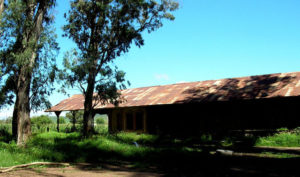
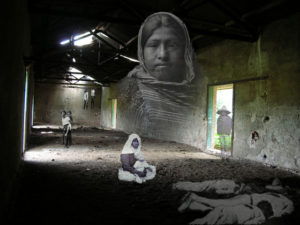
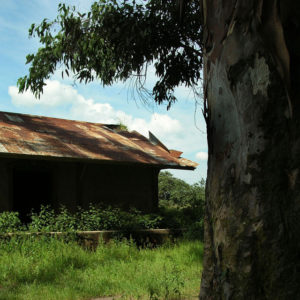
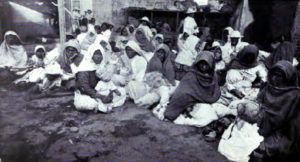
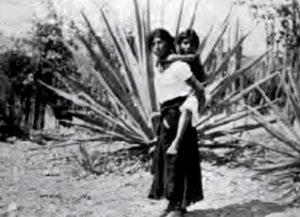
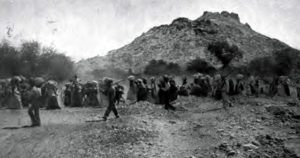
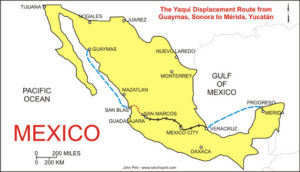
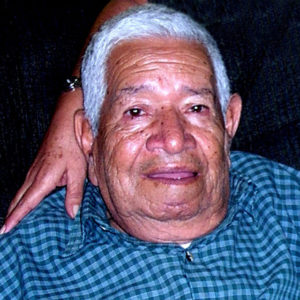
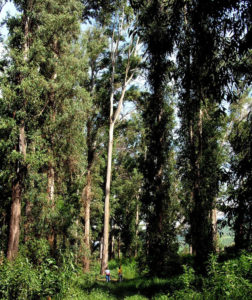
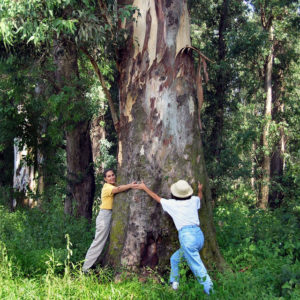
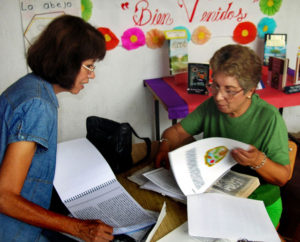
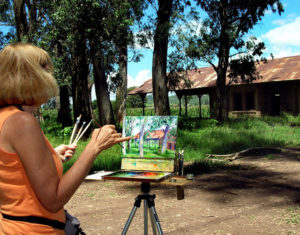

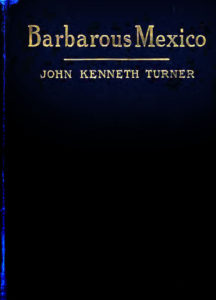
My grandfather always stated he was part Yaqui but had no way to prove it. However, in completing our ancestry information, I have come across his grandfather who has absolutely no other lineage connected to him which led me to wonder if he was correct. It would make sense where the rest of his family came from in Mexico. There are no other “hints” until later in Clifton, Arizona then onto Phoenix and other areas. I will be putting this with our family history book to allow others the opportunity to continue their search and perhaps one day visit the areas you have mentioned. Thank you for sharing this.
You are most welcome. Good luck with the rest of your project, TB.
My father too – dna is 70% Na we were told Yaqui but I’m not certain